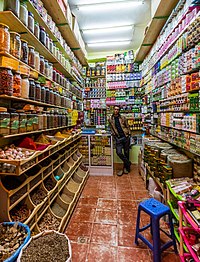
Photo from wikipedia
Engineering materials and their development are essential for a civilized society, and they have always played a key role in the industrialization of a country. The performance of materials can… Click to show full abstract
Engineering materials and their development are essential for a civilized society, and they have always played a key role in the industrialization of a country. The performance of materials can be increased by selecting appropriate fabrication process parameters. In this paper, the effect of fabrication processing parameters on multi-responses of lightweight material, namely, functionalized multiwalled carbon nanotubes-aluminum nanocomposite have been investigated through Taguchi-based grey relational analysis. Ethanol wt. %, milling time, compaction pressure, and sintering temperature were considered controlled parameters. Phase, surface morphology, and chemical compositions of the nanocomposite have been analyzed by X-ray diffraction, scanning electron microscopy, and energy-dispersive X-ray techniques. The scanning electron microscope images revealed that the optimal parameter combination is essential for decreasing void and crack formation during the powder metallurgy process and increasing the material performance index. Grey relational analysis was performed to evaluate optimal sample fabrication processing parameters by using grey relational grade as performance index measurement. The most influential parameter was investigated using main effect plots, interaction plots, contour plots, and analysis of variance. The results show that the optimal combination of sample fabrication parameters is A1B2C3D3. The results also show that the compaction pressure has a stronger correlation to the responses with a 46.92% contribution followed by sintering temperature. The % error between the predicted and experimental grey relational grades at the optimum-level combination is 1.83%. The Monte Carlo simulation data distribution plots show that the ranges of experimental mass density and hardness values are consistent with estimated simulated model values. Further, a regression equation has also been developed to establish the predictive model for the grey relational grade. The model analysis shows that the predictive model is adequate for evaluating grey relational grades. Therefore, this study confirms that the proposed approach can be a useful tool for improving materials’ performance.
Journal Title: Proceedings of the Institution of Mechanical Engineers, Part C: Journal of Mechanical Engineering Science
Year Published: 2022
Link to full text (if available)
Share on Social Media: Sign Up to like & get
recommendations!